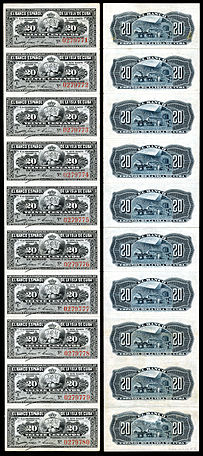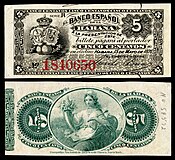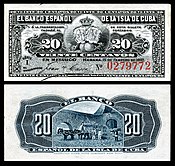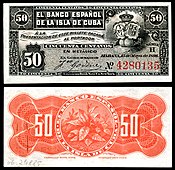Cuban peso
| Cuban peso | |
|---|---|
| peso cubano (Spanish) | |
 A 3 peso banknote depicting Che Guevara | |
| ISO 4217 | |
| Code | CUP |
| Denominations | |
| Subunit | |
| 1/100 | centavo |
| Symbol | $, $MN, or ₱ |
| centavo | ¢ or c |
| Banknotes | |
| Freq. used | $1, $3, $5, $10, $20, $50, $100, $200, $500[1][2] |
| Rarely used | $1,000 |
| Coins | |
| Freq. used | 20¢, $1, $3, $5 |
| Rarely used | 1¢, 2¢, 5¢ |
| Demographics | |
| User(s) | |
| Issuance | |
| Central bank | Central Bank of Cuba |
| Website | www |
| Valuation | |
| Pegged with | 1.00 U.S. dollar = 24.00 CUP |
The Cuban peso (in Spanish peso cubano, ISO 4217 code: CUP) also known as moneda nacional, is the official currency of Cuba.
Until 1 January 2021, there were two currencies in use in Cuba, each called a peso. One was the "Cuban peso"; the other, the Cuban convertible peso (ISO 4217 code "CUC", often called "dollar" colloquially). Each currency was subdivided into one hundred centavos. The CUC was pegged to the US dollar at par, while the CUP was 25 CUP = 1 CUC = US$1, for cash exchanges. Neither currency was traded internationally, and neither could be bought in advance outside Cuba. Both importation and exportation of CUCs is prohibited.[4]
On 10 December 2020, it was announced that CUCs would gradually be withdrawn from circulation, beginning 1 January 2021, leaving the CUP as the only currency in circulation, pegged at US$1 = 24 CUP.[5] From that date, CUCs could only be exchanged in banks or CADECAs, or used in certain shops. [6] This move technically devalued the peso, compared to the "official" 1:1 rate used by Cuban state-owned businesses.[7]
Prior to unification of the currencies on 1 January 2021, Cuban state workers received their basic wages in CUPs, but some also received a portion of their salary in CUCs. Until 2014, most shops accepted payment only in one of the two currencies, depending on whether they were selling staple domestic goods or imported goods. From 2014, many state-owned shops began to accept either currency, in preparation for future unification of the two currencies.
CUC coins are distinguishable from CUP coins, as CUC coins have an octagonal shape within the outer round rim. The only exception is the most common CUP coin, the 1 CUP peso,[8] which also has this octagonal shape; while CUC currency shows monuments, and CUP bills have portraits.
History[]
Before 1857, Spanish and Spanish colonial reales circulated in Cuba. From 1857, banknotes were issued specifically for use on Cuba. These were denominated in pesos, with each peso worth 8 reales. From 1869, decimal notes were also issued denominated in centavos, with 100 centavos for each peso. In 1881, the peso was pegged to the US dollar at par. The currency continued to be issued only in paper form until 1915, when the first coins were issued.
In 1960, the peso lost value after the United States imposed an embargo against Cuba and the suspended the sugar quota; and Cuba changed the peg from the US dollar to the Soviet ruble (at that time US$1 was worth exactly 4 Soviet rubles). The suspension of the sugar quota was the main economic force driving Cuba to seek out the Soviet Union as a new economic partner.
When the Soviet Union dissolved in 1991, the peso lost much of its value with the exchange rate falling to 125 pesos to the US dollar. Recently, it has fluctuated between 23 and 25 pesos to the US dollar. In 1993, during the period of economic austerity known as the Special Period, the US dollar was made legal tender to encourage hard currency to enter the economy. The US dollar was the currency used to purchase some non-essential goods and services, such as cosmetics, and even staple kinds of food and drink.
In 1994, the convertible peso was introduced at a par with the US dollar, and circulated alongside the US dollar. Cuban businesses used an artificial "official rate" of 1 CUP = 1 CUC = US$1, whilst government-owned Cadecas (Casas de Cambio) exchanged cash at "unofficial" but government-set rates, which were closer to the exchange rates in the black-market.
On November 8, 2004, the Cuban government withdrew US dollars from circulation, citing the need to retaliate against further US sanctions.
From 2014, state-owned shops which had previously sold in CUC, began selling in either currency. The government also introduced other exchange rates used by specific types of businesses.
Coins[]

In 1897 and 1898, pesos were issued by revolutionary forces promoting independence.[10] In 1915, cupro-nickel 1, 2 and 5 centavos, silver 10, 20 and 40 centavos and 1 peso, and gold 1, 2, 4, 5, 10 and 20 peso coins were introduced. These coins were designed by Charles E. Barber, who also designed the Barber dimes, quarters, half-dollars for the US. The coins were minted at the US mint at Philadelphia. The gold coins and 2 centavos were not produced after 1916, with the large star design 1 peso ceasing production in 1934. A new silver peso showing a woman, representing the Cuban Republic, beneath a star (the "ABC peso") was issued from 1934 to 1939.[11] Finally, a centennial of Jose Marti commemorative peso (also minted in 50, 25, and 1 centavos denominations) was produced in 1953.
Brass 1 and 5 centavos were issued in 1943, and with copper nickel composition sporadically from 1915 to 1958. Beginning in 1915, 2, 5, 10, 20 and 40 centavos coins were occasionally minted. The last 10, 20, and 40 centavo coins were produced in 1952; these were commemorative issues celebrating the fiftieth year of the republic. As mentioned above, in 1953, silver 25 and 50 centavos commemorative coins were also issued. These were the last silver coins issued for circulation. The last US produced coin was the 1961 five centavo piece.[12]
In 1962, cupro-nickel 20 and 40 centavos were introduced, followed, in 1963, by aluminium 1 and 5 centavos. In 1969, aluminium 20 centavos were introduced, followed by aluminium 2 centavos and brass 1 peso in 1983. Cupro-nickel 3 peso coins were introduced in 1990, with brass-plated-steel 1 peso and nickel-clad-steel 3 peso coins following in 1992. 40 centavo coins were withdrawn from circulation around July 2004 and are no longer accepted as payment. In 2017, the Banco Central de Cuba introduced bi-metallic 5 pesos coin (the difference is the denomination and composition (with a cupronickel ring and a brass center plug). Coins currently in common circulation are 5 and 20 centavos and 1, 3 and 5 pesos; 1 and 2 centavo coins are rarely seen (due to their tiny value) but still valid.
Between 1988 and 1989, the National Institute of Tourism (Instituto Nacional de Turismo, "INTUR") issued "Visitors' Coinage" for use by tourists. In 1981, cupro-nickel 5, 10, 25 and 50 centavos and 1 peso were introduced, followed in 1988 by aluminium 1, 5, 10, 25 and 50 centavos. The INTUR coins were demonetized on October 15, 2001 and were replaced by convertible pesos (CUC).
| Coins of the Cuban peso | |||||||||
|---|---|---|---|---|---|---|---|---|---|
| Image | Value | Technical parameters | Description | Date of first minting | |||||
| Diameter | Thickness | Mass | Composition | Edge | Obverse | Reverse | |||
| 1 centavo | 16.76 mm | 1.4 mm | 0.75 g | Aluminium (aluminium 97.15%, magnesium 2.5%, manganese 0.35%) | Smooth | Coat of arms of Cuba, legend "REPUBLICA DE CUBA", denomination "UN CENTAVO" | "PATRIA Y LIBERTAD" (Fatherland and Liberty) or "PATRIA O MUERTE" (Fatherland or Death), Roman numeral "I" within a five-pointed star, date of issue | 1963 | |
| 2 centavos | 19.31 mm | 1.7 mm | 1 g | Aluminium (aluminium 97.15%, magnesium 2.5%, manganese 0.35%) | Smooth | Coat of arms of Cuba, legend "REPUBLICA DE CUBA", denomination "DOS CENTAVOS" | "PATRIA O MUERTE" (Fatherland or Death), Roman numeral "II" within a five-pointed star, date of issue | 1983 | |

|
5 centavos | 21.21 mm | 1.81 mm | 1.5 g | Aluminium (aluminium 97.15%, magnesium 2.5%, manganese 0.35%) | Smooth | Coat of arms of Cuba, legend "REPUBLICA DE CUBA", denomination "CINCO CENTAVOS" | "PATRIA Y LIBERTAD" (Fatherland and Liberty) or "PATRIA O MUERTE" (Fatherland or Death), Roman numeral "V" within a five-pointed star, date of issue | 1963 |

|
20 centavos | 24 mm | 2.15 mm | 2 g | Aluminium (aluminium 97.15%, magnesium 2.5%, manganese 0.35%) | Smooth | Coat of arms of Cuba, legend "REPUBLICA DE CUBA", denomination "VEINTE CENTAVOS" | "PATRIA O MUERTE" (Fatherland or Death), Roman numeral "XX" within a five-pointed star, date of issue | 1969 |
| 1 peso | 24.5 mm | 1.9 mm | 5.52 g | Brass-plated steel | Segmented reeding | Coat of arms of Cuba, legend "REPUBLICA DE CUBA", date of issue | "PATRIA O MUERTE" (Fatherland or Death), portrait of José Martí | 1992 | |

|
3 pesos | 26.5 mm | 9 g | Copper-nickel | Reeded | Coat of arms of Cuba, legend "REPUBLICA DE CUBA", denomination "TRES PESOS" | "PATRIA O MUERTE" (Fatherland or Death), portrait of Che Guevara | 1992 | |

|
5 pesos | 25.3 mm | 2.27 mm | 7.5 g | Brass-plated steel center in a Copper-nickel-plated steel ring | Reeded | Coat of arms of Cuba, legend "REPUBLICA DE CUBA", denomination "CINCO PESOS" | "PATRIA O MUERTE" (Fatherland or Death), portrait of Antonio Maceo | 2016 |
Banknotes[]
Under the Spanish Administration, the Banco Español de la Habana introduced Cuba's first issue of banknotes in 1857 in denominations of 50, 100, 300, 500 and 1,000 dollars.[13] The 25 peso denomination was introduced in 1867,[13] and the 5 and 10 peso denominations in 1869.[13] During the Ten Years' War, notes were issued dated 1869 in the name of the Republic of Cuba in denominations of 50 centavos, 1, 5, 10, 50, 500 and 1000 pesos.
In 1872, 5, 10, 25 and 50 centavo, and 1 and 3 peso notes were introduced by the Banco Español de la Habana.[14] In 1891, the Treasury issued notes for 5, 10, 20, 50, 100 and 200 pesos. In 1896, the name of the bank was changed to the Banco Español de la Isla de Cuba, and it issued notes in denominations of 5 and 50 centavos[15] and 1, 5 10, 50, 100, 500 and 1000 pesos, followed by 10 and 20 centavos in 1897.[16]
In 1905, the National Bank of Cuba (Banco Nacional de Cuba) issued notes for 1, 2, 5 and 50 pesos. However, the 1905 banknotes were not issued (source: Pick's catalog) In 1934, the Government introduced silver certificates (certificados de plata) in denominations of 1, 5, 10, 20 and 50 pesos, followed by 100 pesos in 1936 and 500 and 1000 pesos in 1944.
Silver certificates[]

During the latter half of 1933, Cuba passed a series of laws to enact the production of Silver certificates (Certificado De Plata). Cuban silver certificates were designed, engraved, and printed by the US Treasury's Bureau of Engraving and Printing from 1934 to 1949 and circulated in Cuba between 1935 and the early 1950s. The eight series of notes were dated 1934, 1936, 1936A, 1938, 1943, 1945, 1948, and 1949 and ranged from one peso to 100 pesos. A Cuban representative was on-site in Washington DC to consult and approve designs.
Banco Nacional de Cuba (National Bank of Cuba)[]
In 1949, the Banco Nacional de Cuba resumed paper money production, introducing notes in denominations of 1, 5, 10 and 20 pesos that year, followed by notes in denominations of 50, 100, 500, 1000 and 10,000 pesos in 1950. Denominations above 100 pesos were not continued. In January 1961, all previous bank notes were demonetized, with new bank notes, printed in Czechoslovakia, placed into circulation. Three-peso notes were added in 1983.
Banco Central de Cuba (Central Bank of Cuba)[]
In 1997, the functions of Banco Nacional as a central bank, including issuing notes and coins, were transferred to a newly created entity, the Central Bank of Cuba.
The 1961 bank notes were demonetized on May 1, 2002.[17] 200-, 500-, and 1000-peso notes were (re-)introduced in 2015. Banknotes currently in circulation are 1, 3, 5, 10, 20, 50, 100, 200, 500, and 1000 pesos.
| Value | Obverse | Reverse |
|---|---|---|
| 1 peso | José Martí | Fidel Castro and his men entering Havana, (January 8, 1959) |
| 3 pesos | Ernesto Guevara ("Che") | "Che" Guevara cutting sugar cane |
| 5 pesos | Antonio Maceo | Conference between Antonio Maceo and Spanish General A. Martinez Campos at Mangos de Baragua (1878) |
| 10 pesos | Máximo Gómez | "War of the people" |
| 20 pesos | Camilo Cienfuegos | Banana harvest and fieldwork ("Development of Agriculture") |
| 50 pesos | Calixto García Íñiguez | Genetic and Biotechnological Centre (es) |
| 100 pesos | Carlos Manuel de Céspedes | Anti-imperialistic tribune "José Martí", Havana |
| 200 pesos | Frank País | Cuartel Moncada, Santiago de Cuba |
| 500 pesos | Ignacio Agramonte | Asamblea Constituyente (Constituent Assembly), Guáimaro |
| 1,000 pesos | Julio Antonio Mella | University of Havana |
CUP and CUC[]
Employees of the Cuban state and of state enterprises are paid their basic salary in CUP, with some paid a performance-dependent bonus in CUC. Staple goods and services not oriented towards foreign visitors are usually paid for in CUP. 'Luxury' goods and services, including most imported goods and anything intended for consumption by foreign visitors, are generally paid for in CUC. Since around 2014, most state shops which used to accept only CUC have accepted either currency, with exchange charts posted by the tills. State shops and markets selling basic foods continue to accept only CUP.[citation needed]
There might occasionally be places which use this system to confuse tourists, and charge them in CUC when they should be charging them in CUP. As an example, this will be like paying US$5 for something that is only worth US$0.20.[18]
From 2011 until 31 December 2020, the official rate is 1:24 to exchange CUC cash for CUP and 25:1 the reverse.[19] Exchange rate websites often show misleading rates for the CUP.[citation needed]
On 1 January 2021, the Cuban government began a long-awaited process of currency unification that will see all CUCs converted into CUPs (at a rate of one to 24) by the end of June 2021.[20]
Exchange rates[]
Commercial bank exchange rates are published on their Facebook page by the Cuban bank, Banco Metropolitano.[21]
| Current CUP exchange rates | |
|---|---|
| From Google Finance: | AUD CAD CHF EUR GBP HKD JPY USD |
| From Yahoo! Finance: | AUD CAD CHF EUR GBP HKD JPY USD |
| From XE.com: | AUD CAD CHF EUR GBP HKD JPY USD |
| From OANDA: | AUD CAD CHF EUR GBP HKD JPY USD |
| From fxtop.com: | AUD CAD CHF EUR GBP HKD JPY USD |
See also[]
- Cuban convertible peso
- Central banks and currencies of the Caribbean
- Economy of Cuba
- Demurrage (currency)
References[]
Notes[]
- ^ Cuba new 200-, 500-, and 1,000-peso notes to be issued 01.02.2015 BanknoteNews.com. January 16, 2015. Retrieved on 2015-01-17.
- ^ Cuba new 200-, 500-, and 1,000-peso notes confirmed BanknoteNews.com. February 15, 2015. Retrieved on 2015-02-16.
- ^ The World Factbook, 2008 est.
- ^ http://www.jibacoacuba.net/currencies.html
- ^ Cuba to End Dual Currency System in 2021 Amid Crisis Reform
- ^ http://www.cubadebate.cu/noticias/2021/01/02/red-de-tiendas-de-la-corporacion-cimex-y-tiendas-caribe-que-aceptaran-cuc/
- ^ Cuba to devalue peso steeply in January in major monetary overhaul
- ^ "1 peso at Numista". Numista.
- ^ Cuhaj 2009, p. 299.
- ^ "The Story Behind the 1897 Cuban Peso and the 1898 Peso". Archived from the original on 2016-03-03. Retrieved 2013-04-17.
- ^ Do You Know Your ABC's?
- ^ "LA MONEDA CUBANA". Jose Maria Aledon, La Moneda Cuba. 1999.
- ^ Jump up to: a b c Cuhaj 2010, p. 397.
- ^ Cuhaj 2010, p. 399.
- ^ Cuhaj 2010, p. 401.
- ^ Cuhaj 2010, p. 402.
- ^ source: Banco Central Cuba, Granma, February 27, 2002
- ^ "33 Tourist targeted scams in Cuba". Travelscams.org. Retrieved 2019-06-16.
- ^ "Central Bank announcement 12 March 2011". Cuban Centrai Bank. 24 March 2011. Retrieved 2017-03-24.
- ^ Yaffe, Helen. "Day Zero: how and why Cuba unified its dual currency system". LSE Latin America and Caribbean blog. Retrieved 2021-02-17.
- ^ [https://www.facebook.com/search/top?q=Banco%20Metropolitano%20S.A.
Sources[]
- Krause, Chester L.; Clifford Mishler (1991). Standard Catalog of World Coins: 1801–1991 (18th ed.). Krause Publications. ISBN 0873411501.
- Pick, Albert (1994). Standard Catalog of World Paper Money: General Issues. Colin R. Bruce II and Neil Shafer (editors) (7th ed.). Krause Publications. ISBN 0-87341-207-9.
- Cuhaj, George S., ed. (2009). Standard Catalog of World Gold Coins 1601–Present (6 ed.). Krause. ISBN 978-1-4402-0424-1.
- Cuhaj, George S., ed. (2010). Standard Catalog of World Paper Money General Issues (1368-1960) (13 ed.). Krause. ISBN 978-1-4402-1293-2.
External links[]
- Cuba Currency Guide—One country, two currencies.
- Cuban Bank Notes
- The banknotes of Cuba (incl. FEC) (in English and German)
- ISO 4217
- Peso
- Circulating currencies
- Economy of Cuba
- 1857 introductions
- Currencies of the Caribbean
- 1857 establishments in the Spanish Empire





